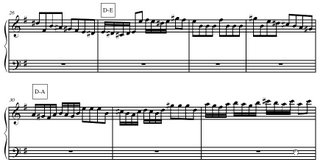I’m starting this sonata with the development, which is sketched out below. It starts in D major with what I think will be second subject material, then modulates through b minor to B major.

It takes the circle of fifths back to G major. The sixteenth-note figure plays a prominent role without alteration except transposition. The repeated quarter note on beats three and four in measure 19 morph into repeated eight notes with an initial jump down.

I stole the idea of a repeated eighth-note bass line from Haydn’s sonata H.XVI:1, Andante movement. It helps the rhythmic drive of the sixteenth notes in the right hand to bring the music to the recapitulation.



















